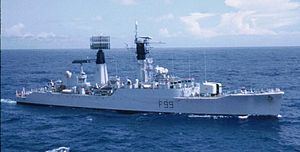Laid down 1 June 1955 Fate Scrapped 1983 Launched 6 April 1959 | Ordered 28 June 1951 Commissioned 7 July 1960 Construction started 1 June 1955 Draft 4.72 m | |
 | ||
HMS Lincoln (F99) was a Salisbury-class or Type 61 aircraft direction frigate of the British Royal Navy.
Contents
History
She was built by Fairfield Shipbuilding and Engineering Company in Govan on the River Clyde. The ship was laid down in 1955, launched 6 April 1959, and completed 7 July 1960. She was named after the city of Lincoln, Lincolnshire.
HMS Lincoln was the only Royal Navy vessel with red-painted gunnels, a tradition dating back to 1693 when the first ship of that name claimed the right to mount her guns on 'Lincoln Scarlet' in memory of Robin Hood, who purportedly favoured the colour.
In October 1973 she took part in the Second Cod War under the command of Commander D Howard RN. and was substantially damaged in action whilst attempting to ram the Icelandic gunship Óðinn. Armed with a protruding girder fixed to the forecastle whilst protecting the British fishing fleet, she was set upon by three Icelandic vessels and forced to withdraw after taking several hits. She returned to Portsmouth for repairs but saw limited action thereafter.
In April 1974 HMS Lincoln was decommissioned at Chatham and placed in the reserve fleet. With the onset of the Third Cod War in 1976, Lincoln received a short refit for patrol duties with improved wooden padding on the bow area for ramming reinforcement. Lincoln was on trials working up, when settlement was reached over the fishing conflict.
In 1976 the New Zealand Government had enquired as to the availability of second hand frigates to replace the RNZN Type 12 Taranaki, and HMS Lincoln was one of four RN frigates, the Wilson government offered to sell, the others were HMS Lynx, Yarmouth and Hardy. The Lincoln was rejected because by this time the 174 Sonar had been removed, and refitting a sonar was difficult and because the RNZN wanted a full Leander. Therefore the Lincoln carried out a tour of duty in the Arctic Circle and also served as the guard ship in Gibraltar during late 1976. She was finally returned to the standby squadron in Chatham in December 1977. During 1978 she was sold to Egypt with Salisbury and Devonshire, but the deal eventually fell through, after Lincoln's fellow surviving Type 61 had sailed for Egypt. In 1979 the Lincoln served its final active commission under the guise of a training ship for submarine engineers, the Oberons using similar engines.Some reports suggest during this final deployment see was also used in Arctic waters operating with HMS Bulwark, too provide radar cover of the initial sea trials of the Sea Harrier, the Lincolns 966 and 986 radars being used in combination with Bulwarks 986 radar to provide good radar tracking over Scandinavia. The 986 radar had been fitted to three Type 61s, Bulwark and Ark Royal about 1970 as a partial replacement for the over complex 984 3D radar on the carriers. Offered for sale and or modernisation after the 1981 defence cuts, she was sold to Bangladesh, but the transfer did not take place and it is unclear whether in other events she could have been reactivated for the Falklands as her range and 965/986 radar were ideal.
